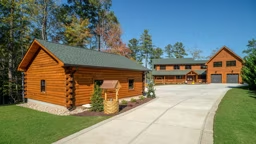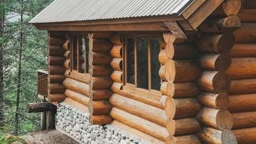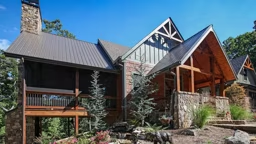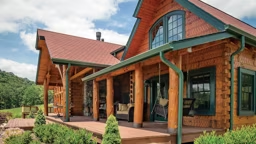
All homes suffer damage of one kind or another from time to time. As a log home owner, you should be aware of the types of repairs or fix-its required on your home, what you can do yourself, and what should be left to a professional. Proper design and continuing maintenance are essential. For example, the home should be built on a well-drained site, with the first logs two to three feet above grade. The roof should overhang the walls by two to three feet. These design features keep water off the logs. It’s a fact, however, that eventually repairs will be needed. Some will be minor, and others necessitated by serious events.
Exterior Structural Damage
If a car was to crash into the side of your home, some logs might be so damaged that they may need to be replaced. Making such a repair is not outside the scope of a reasonably handy owner, but it’s a big job. First, get the replacement logs from the company that milled the original logs. If you can’t get them there, try local mills or a special log home repair company. Then you would need a heavy-duty reciprocating saw to cut the damaged portion away. You might also need to use metal-cutting blades to cut through any spikes or bolts that held the old log in place. If the damage is wide or high enough, the wall might have to be jacked up while the work is being done, generally a task for professionals. Once the damaged log sections are out, the new log sections are installed and toe-nailed into position.
Rot
Rot in the logs of a log home is an indicator of a moisture problem. Both the rot and the underlying problem must be dealt with right away. For rot, cut away the damage. Buy log sections to match and make the repair as described above. Coat the new log sections with finishes that resist insects, mold, and mildew, and complete the work with a coating that allows the log to “breathe” — that is, allows water vapor inside the log to escape while at the same time repelling moisture. The underlying problem leading to the rot is usually exposure to too much moisture, and the logs are never allowed to fully dry. If you have no gutters above the damage, consider installing them. Fix leaky gutters. Cut back shrubbery whose leaves continuously rub against the logs; rainwater on them is transferred to the wood. Move fireplace woodpiles away from the log walls.
Insect Damage
Termites and carpenter ants are prevalent in most parts of the country. Logs properly treated and maintained are not vulnerable to the damage these kinds of insects cause. But you should be on your guard. Telltale signs are little piles of sawdust below the holes insects bore. Termites and carpenter ants like wood that is moist. If you find insect damage, look for underlying causes that keep the logs moist. Eliminate the excess moisture and generally you won’t have any further insect problem. You can plug insect holes with insecticide; you can pour in borates or insert borate plugs. Borates are nontoxic to humans but lethal to insects and are widely available from log home maintenance companies.
Accidental Damage
On occasion, you may accidentally take a chunk out of your wall. Many homeowners may just decide it’s a “character feature” and leave it alone. If you decide to fix it, you have several options. If the damage is small —an indent or an impression — you could try to swell it out again by holding a wet, hot wash cloth on it for a minute or two. The hot water will cause the wood fibers to expand to their original shape. This technique is used by cabinet-makers to eliminate “hammer blossoms.” If a chip was knocked out, you could do one of two things: Glue it back in or sand and refinish the place the chip came from. Both repairs have their challenges. If you glue the chip in, Elmer’s glue will be just fine. Use a thin film of glue and wipe away the excess. Pressure needs to be applied until the glue is dry, about 24 hours later. (Pressure ensures that the glue enters the cellular structure of the wood, otherwise the adhesion will be weak). With small chips, the pressure can be applied with masking tape, which is gently removed when the glue is dry. Larger work may need some sort of slanted board pressing against it for a day. If you need to, sand at the edges of the repair with 80-grit sandpaper, working gently.











